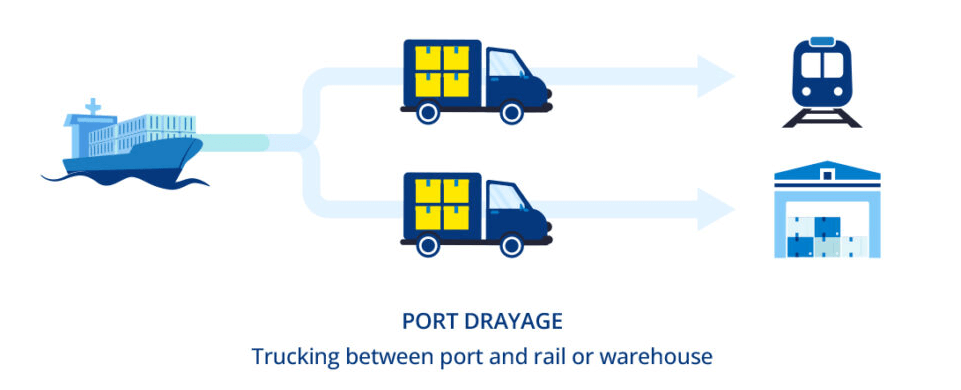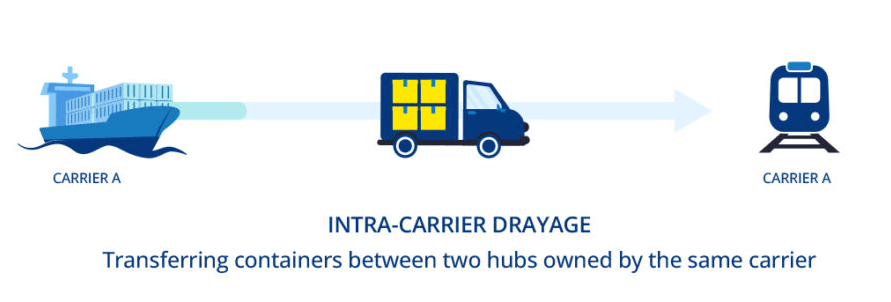Understanding drayage is vital for businesses involved in international trade to ensure cost-effective supply chain operations.
Today’s post introduces some information about drayage transportation. Let’s take a look.
What does drayage mean?
Drayage in shipping refers to the movement of containers and cargo between ports, warehouses, and other facilities over a short distance. Both the starting point and the destination are in the local area.
For example, if you are shipping a container from a warehouse in Yiwu, China to an Amazon FBA warehouse in New York, USA, you need at least two drayage services:
- Transporting your container from the warehouse in Yiwu to the port of Ningbo-Zhoushan.
- Transporting your container from the Port of New York and New Jersey to your Amazon FBA warehouse.
You can hire a freight forwarder or third-party logistics to provide drayage services for you. Professional third-party shipping providers are usually located near transportation hubs such as ports, railway stations, or warehouses to save shipping time.
What are the different types of drayage?
There are six types of drayage. And I have added pictures of the import process under each category for your reference.
Port or pier drayage
Port or pier drayage refers to the transportation of containers and goods between a port and nearby railways or warehouses.

Pic Source: Freightos
Intra-carrier (IMX) drayage
This type of drayage is used when containers need to be moved from one location to another within a single carrier’s network. This logistics process is much simpler because they are managed within the same company.

Pic Source: Freightos
Inter-carrier drayage
Inter-Carrier drayage refers to the transportation of containers from one location to another, utilizing the cooperation between multiple carriers to the final destination. This may include the transfer from rail to sea, rail to rail, or sea to rail.

Pic Source: Freightos
Shuttle drayage
This drayage type can be used to transport containers between different warehouses or distribution centers, primarily to move containers from an overloaded transit hub to a temporary storage site.

Pic Source: Freightos
Expedited drayage
This method is used when time is tight and fast transportation is needed. For example, frozen products and medical products need to be transported quickly.

Pic Source: Freightos
Door-to-door drayage
This is trucking direct from the transportation hub to the end customer, without stopovers. Therefore, goods delivered via door-to-door transport are not stored in warehouses.

Pic Source: Freightos
How are drayage costs calculated?
The drayage is determined by trucking companies with no fixed fee standard, and their prices are very flexible. Factors such as shipping distance, cargo weight and volume, and cargo types can all affect it.
Distance: Some trucking companies have their own fixed routes and will charge according to the number of times, such as $85 at a time. Some will be charged according to mileage. For example, the standard fee for a 20-foot container trailer is around $0.3-$0.7 per kilometer, while others are more expensive.
Cargo dimension and weight: Most goods are transported in three types of container trailers: 20-foot, 20-foot tri-axle, and 40-foot.
The fastest and cheapest shipping option is a standard 20-foot container weighing 38,500 pounds or less, which includes the truck and trailer.
The 20-foot tri-axles are typically used for shipping overweight containers, which have stronger stability and are more expensive than standard 20-foot trailers.
The 40-foot container is the largest container size and can accommodate 45,500 pounds of cargo. It is the most expensive equipment.
Cargo types: Any other handling or special equipment required for overweight, refrigerated, or dangerous cargoes require additional charges.
In addition to basic fees, additional fees may include:
Trucking overnight fee: If your goods can not be shipped on the same day due to a long loading time or customs inspection, this situation will result in overnight charges.
Trucking wait fees: Due to low loading efficiency or failure to release cargo timely, trucks that have arrived at the designated location may have to wait for an additional period of time, which exceeds the original loading time, thus incurring the trucking wait fee. Normally, the standard loading time for a 20-foot container is within 3 to 5 hours. For a 40-foot container, the standard time is within 5 to 6 hours.
How to reduce extra drayage costs?
Additional drayage fees may be a huge cost, but you can plan ahead to avoid it. Below I list a few practical tips for you to consider:
Provide accurate documents
If your imported goods are easily inspected by customs (e.g. products with electrical components, liquids and powders), in addition to certain clearance documents, you must also prepare other necessary documents and certificates in advance. To avoid situations where goods are detained by customs due to incomplete or inaccurate documentation, it will affect the delivery time.
Pre-process customs clearance
You can entrust a competent freight forwarder to help you handle customs clearance in advance. You only need to pre-prepare the necessary documents. Once the goods arrive at the destination port and there is no problem with customs auditing, you can pick them up directly. This can prevent trucks from staying long at the port and charging waiting fees.
Book trucks in advance
Before your cargo arrives at the destination port, you can contact a trucking company. You should book a suitable truck based on the situation of the goods, and arrange the route and delivery time in advance to ensure timely pick-up.
How to tell drayage, intermodal and cartage?
Drayage vs intermodal
Drayage is typically used for short-distance road shipping, while intermodal involves using two or more modes of transportation, such as by sea and by air for long-distance shipment.
Usually, drayage is part of an intermodal shipment. For example, goods can be shipped by sea to a port, then by a short-distance truck to a nearby distribution center before being transferred onto a train to the final destination.
Drayage vs cartage
Cartage and drayage both involve transporting goods via roads.
Drayage specifically refers to transporting entire containers, and the trucks used are typically specialized for handling containers or other types of cargo.
Cartage is a more localized service that involves breaking down the cargo within a container into smaller containers or trucks. It focuses on moving goods over shorter distances and may involve using smaller vehicles such as vans or pickups, as well as using hand trucks or other wheeled equipment.
As a leading sourcing company in China, Jingsourcing has helped 4000+ clients to get their goods delivered accurately and quickly. Many of our long-term freight forwarders offer competitive shipping rates, and they are experienced in handling many logistics-related issues, including all types of drayage services.
